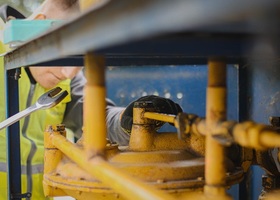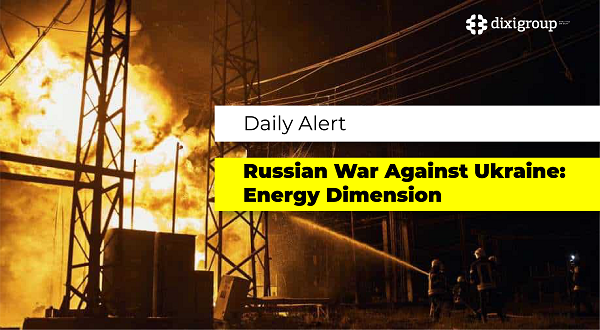Carbon Trap. How Climeworks Startup Builds a Business
Risks and prospects of technology that should stop the climate crisis

A year ago, climate startup Climeworks launched the Mammoth plant for the utilization of carbon dioxide (CO2) in Iceland - the largest in the world. But now this ambitious project is in crisis and is forced to lay off workers. Even the support of such powerful investors as Microsoft Corporation, investment bank UBS, international clothing chain H&M and reinsurance company Swiss Re did not help.
Ukrainian Energy has figured out the reasons that led the revolutionary technology to failure, and found out whether there are chances for its rehabilitation for distribution on the market.
Risky decarbonization
The Climeworks press service recently notified the market that “after a phase of rapid growth,” the company is resorting to cutting 106 employees, 78 of whom are in Switzerland, the startup’s country of origin. Thus, about 25% of employees have been laid off. “We are actively adapting our organization to maintain flexibility and efficiency. In Switzerland, we are negotiating a social plan,” the startup, which emerged from the Zurich Polytechnic University (ETH) in 2014, said in a statement.
According to official information, Climeworks continues to “position itself well technologically and commercially,” “is taking its core technologies to the next level and is seeking to further diversify its commercial offering to expand its market influence and strengthen its role as the undisputed leader in carbon capture.” However, analysts have been cautious about such plans, as more and more studies point to the dubious effectiveness and prospects of this technology.
The most recent example is the problems in the United States with the planned Climeworks installation for removing CO2 from the air on a large scale. “Under the Trump administration, state funding is likely to be cut,” the Neue Zuercher Zeitung notes, adding that this poses significant risks for the startup, which has relied heavily on strong demand in the US market.
On paper, Climeworks’ idea looked promising. But as the first large-scale Orca plant was built in Iceland, it became clear that it would be quite difficult to implement. The plant was supposed to remove about 3,000 tons of carbon from the air each year, which is roughly equivalent to the annual emissions of 450 Europeans. But last year, the company admitted that it had fallen short of its goals. In 2023, Orca absorbed only about 1,000 tons, a third of what was planned, and in 2022, it absorbed only 487 tons.
The second plant, Mammoth, is ten times larger than Orca (it is designed to remove 30,000 tons of carbon). This project has also faced negative reviews. It also fell significantly short of the plans: in 2024 it was possible to remove just over 100 tons of CO2.
Climeworks confirms this figure, although it believes that experts are misinterpreting it, since the construction of Mammoth is not yet complete. Climeworks co-founder and co-director Jan Wurtzbacher admits that the result is “still below expectations.” The reasons are mechanical problems that are being resolved and a delay in the supply of filter materials.
However, investors are concerned that the Mammoth plant is facing the same serious difficulties as its predecessor, Orca. The main problem, Jan Wurtzbacher explains, is the harsh Icelandic weather, which causes parts of the plant to freeze and fail. “Although these factors are trivial, they take time to resolve,” he says.
Constructive criticism
And Climeworks is running out of time to prove its worth, according to the latest findings from researchers at the Massachusetts Institute of Technology (MIT), who are critical of the technical and economic challenges of the direct carbon capture technology that Climeworks is trying to scale up.
According to MIT experts, the technology faces fundamental barriers that, despite all the improvements, will keep it too expensive. “Although CO2 affects the climate and contributes to global warming, its concentration in the atmosphere is only 0.04%. To remove one ton, 1.8 million cubic meters of air must be treated - this volume is equal to 720 Olympic swimming pools. This entails enormous energy and investment costs,” the MIT study says. Another problem is location. Air is everywhere, but storing CO2 also requires cheap, carbon-free energy, plenty of water, porous rocks that can hold the gas, and stable weather to keep costs down.
Despite the criticism, the MIT scientists are not calling for the abandonment of carbon capture and storage technology, as it will be needed to offset unavoidable greenhouse gas emissions, such as from aviation and agriculture.
But they warn: we should not entertain false hopes that tomorrow it will be possible to cheaply and easily remove existing emissions from the air. If the technology does not work, humanity will have to spend more money on adapting to climate change. In the worst case, this will undermine confidence in global climate policy.
An encouraging partnership
Climeworks aims to prove that the above-mentioned fears are in vain. In April this year, the company appointed a new CTO, who led a team of 150 engineers and scientists. Their task is to implement the ambitious ideas of the founders in the harsh conditions of Icelandic reality. Jan Wurzbacher expects the Mammoth installation in Iceland to operate at full capacity by early 2027.
Optimism is provided by the fact that on June 16, the startup Climeworks created an “alliance to advance decarbonization” with SAP, one of the world’s largest companies in the business software development market. “The companies’ multi-million dollar agreement will provide 37,000 tons of diverse, high-quality carbon removal credits and offsets. By 2034, Climeworks will remove CO2 for SAP through a portfolio of technology solutions, including direct air capture, biochar, and enhanced rock weathering, specifically tailored to SAP’s business context,” the statement said.
How carbon capture works
Carbon is created by burning fossil fuels. Once in the atmosphere, it traps heat near the Earth’s surface, lingering for hundreds of years and contributing to global warming.
The process, known as carbon capture and sequestration (CCS), is now seen by many as an important tool for reducing emissions as renewable energy sources are developed to replace fossil fuels. But it is increasingly being criticized by some business people who see it as too expensive and unnecessary, and by environmentalists who say the technology is failing to deliver the promised results and is actually allowing oil, gas and coal companies to continue operating.
Currently, industrial plants can install equipment to separate CO2 from other gases before it comes out of the chimney. The carbon dioxide is then compressed and transported (usually by pipeline) to a location where it is injected deep underground for long-term storage.
There are also facilities that capture CO2 directly from the atmosphere, using special filters or chemicals. Professional equipment allows the carbon to be injected under high pressure almost 3 km underground into geological formations that can store it for years.
CO2 is also stored in salt or basalt formations or in depleted coal seams where mining has stopped. But according to the International Energy Agency, about 75% of the captured carbon is actually injected back into the oil fields to increase pressure and facilitate extraction — meaning it is not stored forever.
The most common technologies allow capturing about 60% of CO2 emissions during the production process. Above this level, it is technically difficult and financially burdensome, IEA analysts believe.
Some companies have promised capture rates of 90% or more, but “in practice, this has never happened,” says Alexandra Shaykevich of the Environmental Integrity Project. “The reason is the inability to cover all carbon emission points at enterprises,” explains Grant Hauber of the Institute for Energy Economics and Financial Analysis.
Environmentalists also point to the risks of leaks from storage facilities. For example, in 2023, Archer-Daniels-Midland discovered a CO2 leak about 1 km deep in the US state of Illinois, after which local authorities banned CCS in the area of an important source of drinking water - the Mahomet aquifer.
CCS technology can be useful for hard-to-capture sectors, such as the cement or steel industries, but environmentalists believe that it harms the environment by allowing the continued extraction and burning of hydrocarbons.
The scale of the technology
According to statistics from the IEA, in 2023 there were about 45 carbon capture plants operating in the world, which together captured 50 million tons of CO2 - an extremely small fraction of the 37.8 gigatonnes of total emissions in the energy sector. When all greenhouse gases are included, global emissions in the same year were 53 gigatonnes, according to the Emissions Database for Global Atmospheric Research.
One of the world’s largest projects, ExxonMobil’s Shute Creek facility in Wyoming, captures only about half of its CO2, and most of that gas is sold to oil companies for secondary oil production.
Despite everything, carbon capture remains an important tool for reducing emissions, especially in heavy industry. Sangeet Nepal from the Carbon Capture Coalition is sure of this. “This is not a replacement for carbon-free renewable sources… It is just a supplement, one of the pieces in the big puzzle of combating climate change,” he concluded.
Svitlana Dolinchuk, specially for “Ukrainian Energy”








